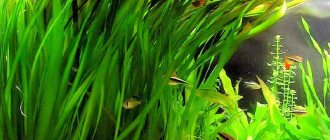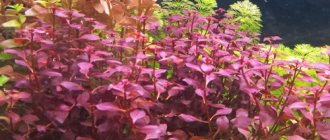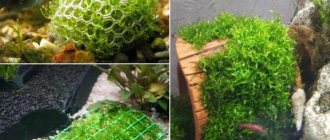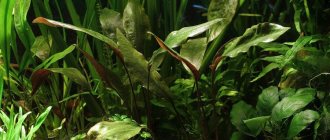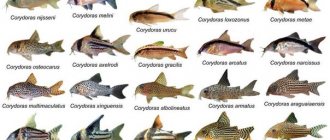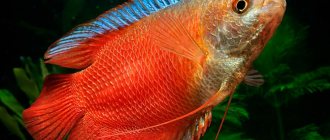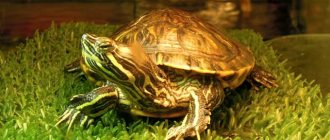Species of Cryptocoryne Wendt
Cryptocoryne wendta includes species of different sizes and colors:
- Mi oya.
- Green.
- Brown.
- Tropic.
- Green gecko.
- Flamingo.
- Florida sunset.
- Green jack.
- Broadleaf.
- Rubella.
- Beckett's petsch.
- Pontederifolia.
- Heart-shaped.
- Griffith.
- Minima.
- Yellow.
Mi oya
Cryptocoryne wendtii Mi Oya grows in the river Mi Oya of the same name. It has red-brown colored leaves. Grows up to 30 cm, suitable for large containers.
Green
Cryptocoryne wendtii Green is suitable for miniature aquariums due to its height of 10 cm. The foliage color of Cryptocoryne wendtii Green is bright light green.
Tropica
Cryptocoryne wendtii Tropica is a rosette bush 15 cm high. The leaves of Cryptocoryne wendtii Tropica are dark colored and have a hammered pattern.
Brown
Сryptocoryne wendtii Brown or cryptocoryne wendtii brown grows up to 25 cm and, due to its size, needs additional feeding. The foliage of Cryptocoryne wendta brown is bronze-brown.
View this post on Instagram
Posted by Terra Aquatica (@terraaquatica) Jul 14, 2021 at 8:47 am PDT
Green gecko
Cryptocoryne Wendtii Green Gecko lives on the island of Sri Lanka and reaches a size of 15 cm.
Flamingo
The Flamingo variety is distinguished by its pinkish coloration of the stem and leaves. Brought out by breeders.
Florida sunset
A small plant whose distinctive feature is the color of its leaves. Most often, the leaf is half colored pale pink and the other half green, or the leaf is pink with splashes of green.
Green jack
The leaves are brownish-brown in color and edged with green.
broadleaf
It is considered the ancestor of all other varieties. The bush is small in size, 10 cm, and the leaf length reaches 20 cm. The leaves are green-brown.
Rubella
The bush grows up to 13 cm and is distinguished by shortened petioles. The foliage is dark brown on top and gray underneath.
Description
The habitat of Cryptocoryne Wendtii is South and Southeast Asia. It is found in large quantities in the rivers and lakes of Sri Lanka. May have green, red, brown leaves. Shades vary depending on the aquatic environment. The structure and dimensions of the leaf apparatus are varied. The shrub grows from 10 to 35 cm in height. Cryptocoryne wendta is a favorite plant of shy fish, which use it as a shelter, and females lay eggs.
Maintenance and care
Cryptocoryne is distinguished by its endurance and rapid adaptation to new conditions, so caring for the plant is not difficult. To keep the bush healthy, it is enough to keep the aquarium clean and monitor the water parameters.
Aquarium volume
The height of the aquarium is about 50 cm, since the bush can reach 30 centimeters, and the area is selected depending on the number of bushes. The distance between plants is 8–10 cm. The bush feels comfortable in small and large aquariums.
Lighting
Artificial and sunlight are equally suitable. The lighting should not be too bright; it is better to create diffused light or light shadow.
For artificial light, incandescent and fluorescent lamps with a power of 0.5 W/l are used. Daylight hours are 9–11 hours.
Priming
The soil must contain silt. To achieve siltation of the bottom, add peat or clay to the water. When filling the substrate, make sure that the soil layer is at least 3 cm, but not higher than 6 cm.
For better growth of cryptocoryne, mix coarse sea sand with small pebbles or crushed stone in equal parts. In such soil, wendta develops and grows evenly.
If you plant cryptocoryne not in water, but on a dry piece of land, then the soil should contain peat and clay to maintain moisture.
Water parameters
Wendta is a tropical plant, such an environment means high temperatures. Therefore, maintain the water temperature at least 23 degrees. But do not raise the temperature above 30 degrees. Comfortable temperature is 24–27 degrees.
Any acidity is suitable, even alkaline and sour. But average values of 6–8 pH are preferable.
But Vendta is more demanding when it comes to water hardness. Water that is too soft is unsuitable and causes growth to slow down and leaves to fall off. Comfortable hardness levels are considered to be 8–15 dH.
Aeration
The plant does not need aeration too much, but if possible, install a medium-power compressor.
Filtration
Turbidity and particles in the water settle on the leaves and interfere with photosynthesis. To maintain cleanliness, purchase a powerful filter.
Top dressing
When keeping a bush together with fish, additional feeding is not required, because the remains of the fish’s vital activity sufficiently fertilize the soil. But even in a herbal garden without fish, the plant can do without fertilizers, but if possible, it is still better to feed the bush. Add a minimal amount of iron, copper, boron and other minerals to the water, and the plants will feel better and healthier.
Cryptocoryne Wendt. Home aquarium
Wendta takes root well in various conditions, although it prefers water composition of medium or moderate hardness. Too soft an environment can contribute to loss of decorativeness and rotting of leaves. The ideal temperature for maintenance will be about 24 degrees; at lower temperatures, plant growth may slow down.
Cryptocorynes tolerate both long-term stagnation of water and frequent water changes. Such conditions do not have a special effect on the development and growth of the plant. The bushes also take root well in slightly alkaline or slightly acidic water.
Cryptocoryne Wendt tolerates both artificial and natural light, but in case of direct sunlight, the plant must be covered. To create comfortable conditions, bushes need fluorescent or conventional incandescent lamps. You can also combine these two types of lighting, providing the plant with a full spectrum of radiation. It should be noted that for every liter of water a power of 0.3 W is required.
Cryptocoryne Vendta brown loves moderate lighting with light shading from larger specimens of aquarium plants, which does not affect the color of its leaves. In such conditions, she will feel just as good as in bright lamps. Daylight hours for this plant should be at least 12 hours.
Aquadesign
When decorating an aquarium, the plant is planted in the middle part or in the foreground. To prevent the plant from stretching, you will need bright lighting. In small tanks it is used as background greenery.
The leaves of the plant grow laterally and have a rosette growth pattern, so it is planted next to long plants to create contrast. Cryptocoryne also hides the lower part of tall plants, which often loses its leaves and becomes bare due to lack of light.
Cryptocoryne. Where is this guest from?
Cryptocoryne Wendt is native to the waters of Sri Lanka. This ornamental plant has ruffled leaves and a beautiful bronze hue against a green background. That is why it is especially recommended to grow it in aquariums with a large depth of water layer, where over time dense, incredibly beautiful thickets are formed. Thanks to its small height, up to 20 centimeters, cryptocoryne is ideal for decorating the middle ground of an aquarium; the lower the water level, the more beautiful its leaves are located on the surface, creating a unique landscape. The average width of the bush is 12 centimeters. Cryptocoryne grows quite quickly, however, when kept in small aquariums, its dimensions will be slightly smaller, about 6 cm high and 8 cm wide. In large aquariums, this plant can reach a height of up to 30 centimeters.
Compatibility with other aquarium inhabitants
Compatible with most types. It is especially suitable for predatory fish, but herbivores can spoil and eat foliage.
Compatible:
- Guppy.
- Discus.
- Neons.
- Pecilia.
- Angelfish.
- Mollies.
- Scarlet barbs.
- Cichlids.
- Characinaceae.
- Catfish.
- Botsiya.
Weakly compatible:
- Herbivorous snails.
- Cichlazoma Severum.
- Akara turquoise.
- Cichlazoma Meeka.
- Sumatran barbs.
Cryptocoryne disease - what is it?
Any plant kept in an aquarium is susceptible to cryptocoryne disease. There are a number of symptoms by which you can find out that the plant is suffering from this particular disease. A sure sign of this disease is the softening of the leaf blades, as a result of which they resemble glass. After that they simply decompose.
Most often, the plant suffers from this disease as a result of changes in the conditions of their maintenance. For example, the temperature may drop sharply and the water may become harder. In addition, the initially created environmental conditions can also cause the occurrence of cryptocoryne disease. In addition, you should not replant the plant too often, because it does not like to be disturbed. It is better to avoid the need for a transplant.
However, experts say there is a treatment for cryptocoryne. To do this, you need to change the water and clean the soil. This will help save the most important part of the plant, namely its rhizome, from which a new individual will subsequently grow.
Diseases and prevention
A common disease associated with this species is cryptocoryne disease. The causes are unknown; aquarists believe that the disease is caused by sudden changes in water, light, temperature or improper care. This is also how the plant can react to the ingress of chemical elements that are toxic to vegetation into the water. The disease develops rapidly, and tissue necrosis occurs within a day.
Signs of the disease: leaves soften and split, change color; holes appear due to tissue decomposition.
There are no specific patterns in its appearance, but most often plants get sick in winter. The disease is contagious and quickly spreads to other plants. Therefore, when a diseased plant is discovered, it needs to be dug up and transplanted into a quarantine tank.
There is no definite treatment, but if the disease has not progressed too much, then there is a chance to save the plant’s rhizome. To do this, remove the affected parts, change the water and remove dirt and remnants of old soil from the roots. Place the plants in a separate container.
To prevent the disease, follow the rules of maintenance, keep the water clean, do not raise the temperature above 30 degrees and beware of getting chemicals into the water.
general information
This aquarium plant belongs to the genus Cryptocoryne and to the family called Araceae. In the world it can be found in several forms, of which there are five in total. They all differ in leaf shape, color, and other features. True, out of five people he cultivated only four forms of this plant. The most popular of these forms is Cryptocoryne Wendt's brown. The green variety is not far behind.
Interestingly, this plant coexists with other representatives of the flora without any problems. It will not only create contrast in the aquarium, but also decorate it. If it grows alone, then its leaves will occupy the entire free area and line the bottom with a thick blanket.
Photo gallery
Soil for growing cryptocoryne
It is very important that the soil filling the bottom of the aquarium is of high quality. It must be sufficiently silted. It is necessary to constantly apply fertilizing, which can consist of peat, coal, clay. They should be mixed together before adding them to the soil. It is also sold in specialized stores and is an ordinary aquarium sludge.
Care should be taken that the substrate consists of small pebbles or coarse sand collected from the river. If the substrate is coarse-grained, then the plants that grow in it will appear next to each other. As a result, all the microcomponents necessary for their development become insufficient, and Cryptocoryne grows less healthy and beautiful.
Since this representative of the flora has a powerful root system, it is necessary to lay out a sufficient layer of soil. Its height should be at least five centimeters if you plan to grow a small cryptocoryne. It is not necessary to add mineral fertilizer, but microelements such as boron, copper, ferrous iron, molybdenum and manganese should be added to the soil at least several times a month.

